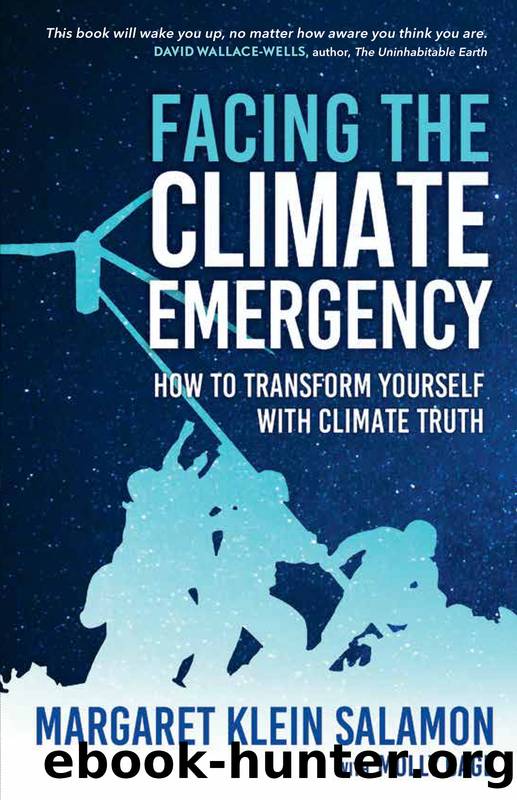Facing the Climate Emergency by Margaret Klein Salamon

Author:Margaret Klein Salamon
Language: eng
Format: epub
Publisher: New Society Publishers
STEP FOUR:
Understand and Enter Emergency Mode
IF THE PRECEDING MATERIAL unsettles and terrifies you, good. We are in terrible danger — you and I; my family and your family. Everyone and everything we love — all life — is in danger. Feel the fear, grieve the future, and let it motivate you to action.
If you have not experienced that fear yet, consider that you might be blocking or avoiding it; try to make space for it and invite it in. Try to visualize what the collapse of civilization will look like, and imagine what it will feel like. Use your imagination to explore what it will feel like while civilization is collapsing: No water coming from the tap; not knowing whether to stay or go. Mass starvations and migrations growing. If you can’t imagine it for yourself, read Octavia Butler’s Parable of the Sower, a novel set in 2025 in partially collapsed southern California. Or read The End We Start From by Megan Hunter. Their depictions of mass internal migration, horrendous flooding, and social breakdown may be the jolt you need.
Most psychological and sociological writing about climate fear focuses on the primitive human responses to crises — “fight, flight, or freeze” — or, alternatively, on the devastation of post-traumatic stress disorder (PTSD). This bleak portrayal of reactions has contributed to collective paralysis. While people can respond to fear by fighting, fleeing, being unable to react, or by later developing PTSD, these, as I’ve argued, are not our only options. We can also be inventive and collaborative in our response. We can use our fear to respond to crises with rationality, focus, moral purpose, and shocking efficacy.
We can transform our economy and society to beat back a global catastrophe. Indeed, we’ve done it before — and rapidly. But to solve an emergency like the climate crisis, we need to collectively and immediately exit “normal mode” and abandon the gradual policy advocacies and enervated emotional states that accompany it. We need a collective awakening, on the scale of our response to a national attack. Together, we need to realize, in accordance with Wilson’s theory of group selection, that we face an existential emergency, that we are in clear and imminent danger, and that we must immediately mobilize with everything we’ve got.
We can do this only when we enter into what I’ve called “emergency mode.” In emergency mode, we can channel our fear to fight the threat facing us collectively and creatively. This is the opposite of panic mode, in which we either freeze or take flight. When we enter emergency mode, we respond to threats with thoughtfulness, planning, and coordination. Our senses are heightened; we feel a preternatural calm; we are able to process large amounts of information quickly to arrive at a flexible course of action.
When a society enters emergency mode, it mobilizes and works collectively to address and solve huge problems quickly. We know we can mount this response because we’ve done something similar before. By looking to history, we can see a path forward for maximal impact on the most pressing problem of our time.
Download
This site does not store any files on its server. We only index and link to content provided by other sites. Please contact the content providers to delete copyright contents if any and email us, we'll remove relevant links or contents immediately.
| Arms Control | Diplomacy |
| Security | Trades & Tariffs |
| Treaties | African |
| Asian | Australian & Oceanian |
| Canadian | Caribbean & Latin American |
| European | Middle Eastern |
| Russian & Former Soviet Union |
The Secret History by Donna Tartt(16611)
The Social Justice Warrior Handbook by Lisa De Pasquale(11486)
Thirteen Reasons Why by Jay Asher(7783)
This Is How You Lose Her by Junot Diaz(5754)
Weapons of Math Destruction by Cathy O'Neil(5032)
Zero to One by Peter Thiel(4818)
The Myth of the Strong Leader by Archie Brown(4786)
Promise Me, Dad by Joe Biden(4441)
Stone's Rules by Roger Stone(4413)
Beartown by Fredrik Backman(4405)
How Democracies Die by Steven Levitsky & Daniel Ziblatt(4393)
The Fire Next Time by James Baldwin(4338)
100 Deadly Skills by Clint Emerson(4072)
A Higher Loyalty: Truth, Lies, and Leadership by James Comey(4027)
Rise and Kill First by Ronen Bergman(4009)
The David Icke Guide to the Global Conspiracy (and how to end it) by David Icke(3876)
The Farm by Tom Rob Smith(3870)
Secrecy World by Jake Bernstein(3774)
The Doomsday Machine by Daniel Ellsberg(3726)
